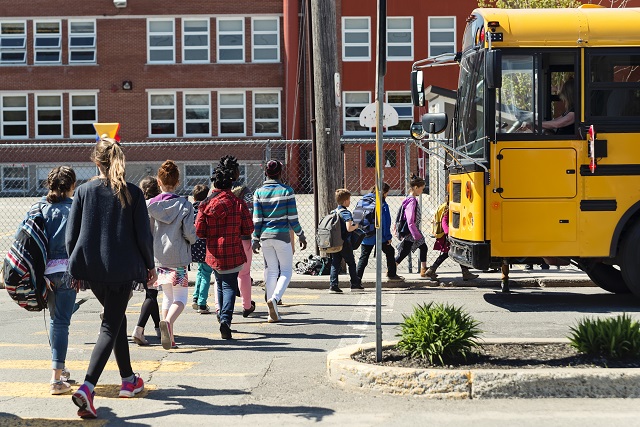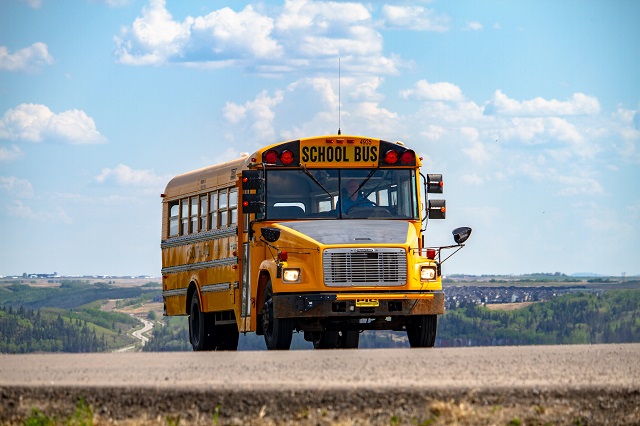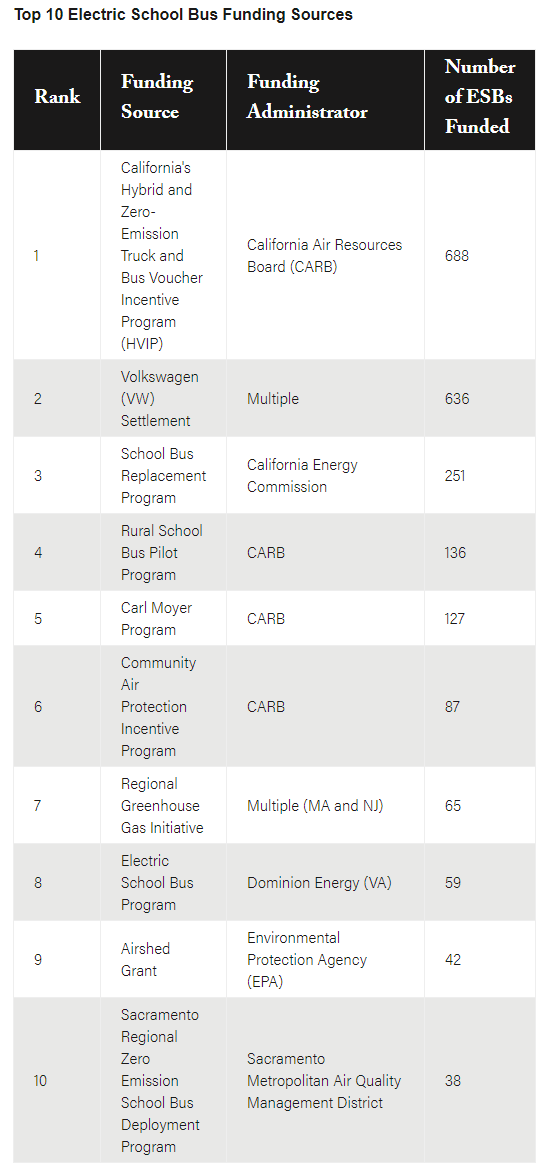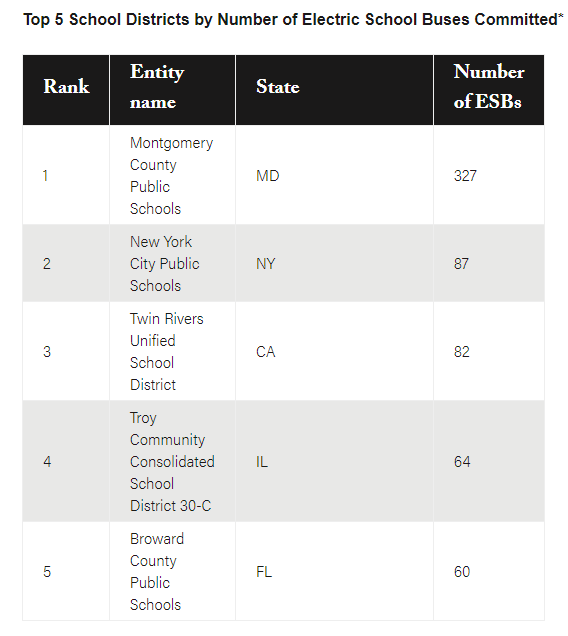
Editor’s Note: This article was updated in September 2022 to present new findings from WRI’s dataset tracking electric school bus adoption in the United States, covering April to June 2022. To the best of our knowledge, these statistics are up to date as of June 30, 2022. Another update will be available in December 2022. Contact leah.lazer@wri.org for previous versions of this article.
Electric school bus adoption continues to expand in the United States.
There are now 12,720 committed electric school buses in 38 states. That’s nearly 500 more buses since the release of WRI’s March 2022 dataset, and an almost 10-fold increase since WRI began tracking electric school bus adoption in August 2021. The vast majority of the buses come from a contract announced at the end of December 2021 between bus dealer Midwest Transit Equipment and SEA Electric, a manufacturer of commercial electric vehicles. This agreement promises to repower 10,000 school buses to electric over the next five years.
This significant rise in electric school bus commitments is a testament to tireless advocacy work at the local, state and federal levels, bolstered by continued funding opportunities across the country.
The large increase in 2021 Q4 is due to a 10,000-bus/five-year commitment by bus dealer Midwest Transit Equipment and SEA Electric, an electric vehicle manufacturer.
Why Are Electric School Buses Important?
More than 20 million children ride the bus to school, and 92-95% of these school buses run on diesel. Diesel exhaust, a known carcinogen, has proven links to serious physical health issues as well as cognitive development impacts. Daily exposure contributes to asthma and other respiratory diseases. Evidence increasingly suggests that children are especially susceptible to these impacts.

Students from low-income families are particularly exposed to the dangers of diesel exhaust pollution: 60% ride the bus to school, compared to 45% of students from families with higher incomes. Children of color are more likely to suffer from asthma, due in part to historically racist lending, transit, housing and zoning policies that concentrated Black and Brown communities closer to highways and other sources of vehicle-based air pollution. In addition, children with disabilities often ride longer on buses. Electrifying the entire fleet of school buses can help address these health concerns and inequalities.
Electric school buses also have no tailpipe emissions, reducing students’ exposure to harmful pollutants that contribute to respiratory disease, heart disease, cancer and physical problems – and which can harm students’ cognitive development. In fact, reducing students’ exposure to air pollution from school buses can have positive and significant effects on student test scores – in some cases, on par with increased teacher experience levels.
Electric school buses also have significantly lower greenhouse gas emissions than diesel or propane-powered school buses, even after accounting for emissions for electricity generation. Plus, unlike other fuels, the use of electric buses will continue to reduce greenhouse gas emissions from the transportation sector as more electricity generation comes from renewable energy. School bus electrification can also offer resiliency support to the electric grid by providing access to large batteries when not in use, and add jobs in the growing electric vehicle industry.
WRI has been tracking electric school bus adoption across the United States and recently released an update covering the second quarter of 2022. Here are key findings and trends from this new data.
The United States Has More Than 12,000 Committed Electric School Buses
We consider an electric school bus “committed” when a school district or fleet operator has been awarded funding to purchase it or has made a formal agreement for a purchase with a manufacturer. Committed buses also include those that have been delivered to the school district or fleet operator and those in operation.
As of June 2022, we identified a total of 12,720 committed electric school buses across the U.S. This represents around two to three percent of the entire U.S. school bus fleet. We also identified 40 new school districts that have committed to adding electric school buses to their fleets, bringing the total to 455. This is a 76% increase in the number of districts from our first count in the summer of 2021, but still a small portion of the total number of districts.
We have data on four phases of the electric school bus adoption process that fit under the umbrella term “committed:” “awarded,” “ordered,” “delivered” and “in operation.” As of June 2022, 767 electric school buses are delivered or in operation – about the size of Hawaii’s entire school bus fleet.
Our research shows that the average amount of time that passes between the awarding of funds to the delivery of the electric school bus is around 16 months. This range varies from less than three months to more than three years, but the amount of time has generally reduced since the first electric school bus hit the roads in 2014. Supply chain issues during the COVID-19 pandemic have exacerbated delivery delays for all school bus types and are expected to continue for some time.
Electric School Buses Are Now Committed in 38 States; California Leads
There are 38 states with committed electric school buses, with buses belonging mostly to districts or entities on the coasts and in suburban areas. California still leads in electric school bus adoption, with nearly 1,400 committed electric buses across the state, 41% of which are delivered or operating. This is more than four times as many buses as the next leading state. Following California, the biggest addition since March 2022 came in Virginia, which gained 58 electric school bus commitments, largely due to funds from the Volkswagen Mitigation Trust. See the other states in the top 10 list below.
Since the first award in 2018, 28 out of 38 states have used VW Settlement funds toward the purchase of 636 electric school buses. However, the VW Settlement still ranks second in the list of largest funding sources, after California’s Hybrid and Zero-Emission Truck and Bus Voucher Incentive Program (HVIP), which has funded 688 buses. Unsurprisingly, California-specific funding sources comprise six out of the ten largest funding sources. The state’s robust incentive programs are part of why nearly three quarters of all delivered and operational electric school buses can be found there.

The Number of Large Electric School Bus Commitments Is Growing
While the contract between Midwest Transit Equipment and SEA Electric to repower 10,000 electric school buses is by far the largest single-contract commitment to date, many other fleet operators have committed to multiple electric school buses. Sixty school districts and private fleet operators now have 10 or more committed electric school buses, compared to 42 school districts in March 2022. Around 30% of all entities with electric school buses have committed to five or more, up from 25% in March. These numbers could suggest growing trust in electric school bus technology and market conditions, as well as wider funding availability.

One Quarter of Districts with Electric School Buses Have Gone Back for More
This update to the dataset includes information on “batches,” or groups of electric school buses that went through the adoption process at the same time. We consider a district’s buses to be in the same batch if any of their adoption phases – when they were awarded, ordered, delivered or first operating – occurred within roughly six months of each other. For example, if a district ordered 5 buses in January 2020 and then orders 5 more in May of 2020, those 10 buses would all be grouped into one batch. This variable can help to demonstrate adoption patterns of individual districts, like how batches differ in size and how long it takes before districts receive a new batch.
Twenty-seven percent of districts with electric school buses have more than one batch, with the most batches (five) belonging to Twin Rivers Unified School District in California. As seen in the graph below, we found that most batches are small, with a median size between two and three buses. However, the batch sizes range widely, suggesting that batch sizes may be largely dependent on the amount and type of funding and financing available at the time.
We also tracked the amount of time that passed between districts’ batches, and found that in general, less time passed between later batches than earlier ones. While we cannot say definitively why this trend exists, it might reflect the increased funding opportunities in recent years or confidence in proceeding with more electric buses after the first batches.
Larger Buses Dominate Electric School Bus Sales
The dataset includes 11 different electric school bus manufacturers, with three major players: Thomas Built Buses, Blue Bird and Lion Electric. While Thomas has the highest number of committed electric school buses, Blue Bird currently leads in the number of buses that have been delivered or are in operation.
School buses are generally classified into four categories based on size and construction: the smaller types A and B, which carry between 10 and 30 passengers, and the larger types C and D, which carry between 50 and 90 students. The top three manufacturers all offer Type C electric models, which is the most common bus type, according to a 2021 maintenance survey conducted by School Bus Fleet Magazine. This aligns with our findings on electric school bus types; 55% of committed electric school buses are Type C, while 25% are the bigger Type D.
Is Electric School Bus Adoption Occuring Equitably?
Adoption trends among areas with different levels of air pollution and income have stayed consistent since our last update, as have the adoption patterns among communities of color. The graph above shows the distribution of electric school buses among school districts with varying percentages of “low-income” households – households earning less than twice the federal poverty level. The number of school districts with electric school buses are spread fairly evenly among low-income quartiles, but this is not the case when you look at the distribution of individual electric school buses. The largest percentage of electric school buses are in the first quartile, with the smallest share of low-income households.
Electric bus adoption appears to be occurring more equitably when looking at how the vehicles are distributed among communities of color. Almost 80% of electric school buses are located in school districts with a high population of non-white and/or Hispanic residents (defined as “Minority” in the Environmental Protection Agency’s EJScreen data). Stakeholders – including policymakers, utilities, nonprofit organizations and teams charged with program design and implementation – should commit to ensuring this trend continues to help address the inequities of on-road air pollution described previously.
As seen in the above chart, school districts with the highest levels of PM2.5 air pollution have committed more electric school buses. The trend differs slightly with ozone pollution. While the highest quartile of ozone pollution also contains the most buses, 25% of buses are in areas with the lowest levels of ozone, compared to three percent of buses that are in areas with the lowest levels of PM2.5. We focused on these two pollutants because of their close linkage to diesel exhaust and the availability of data.
Overall, committed electric school buses are largely concentrated in historically underserved school districts, but more efforts could be focused on ensuring electric school buses are accessible to more low-income communities, in particular. Since an electric bus and associated charging infrastructure currently cost more than a diesel bus upfront, funding incentives are crucial for low-income districts to be able to transition to electric.
However, the metrics we have chosen are by no means comprehensive. WRI will be conducting more in-depth research on the equity of electric school bus adoption and continuing to work alongside partners to ensure that underserved communities remain front-and-center in the transition.
What’s Next To Scale Up Electric School Bus Adoption?
Our most recent update to WRI’s Electric School Bus Adoption dataset saw a steady increase in the number of committed buses, and the number is expected to grow substantially when the EPA announces the first funding awards through the Clean School Bus Program. This new program will grant at least $500 million per year exclusively for electric school buses while prioritizing high-need or low-income, rural, and tribal schools. The EPA is expected to announce the first rebate funding awards for the program in the fall of 2022. Additionally, several states have passed legislation that commits to equitable adoption of electric school buses. We are also seeing more attention on repowers of fossil fuel buses, providing another pathway for districts to electrify their fleets.
If progress toward an all-electric school bus fleet is to continue, policymakers at the federal and state levels, including state utility regulators, need to increase funding opportunities and ensure they are accessible to communities that would benefit most from school bus electrification.
This article was originally published on WRI’s Insights.
Lydia Freehafer is a Research Assistant for NUMO, the New Urban Mobility alliance, hosted by WRI Ross Center for Sustainable Cities.
Leah Lazer is a Research Associate with the Electric School Bus Initiative at World Resources Institute and NUMO, the New Urban Mobility Alliance, hosted by WRI Ross Center for Sustainable Cities.
Data visualizations by Rosie Ettenheim.





